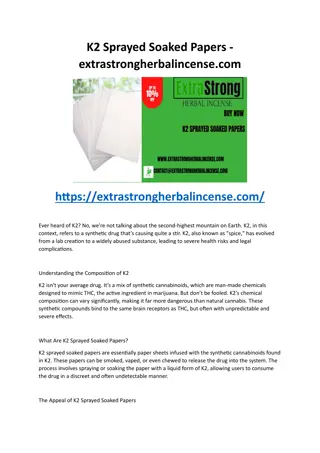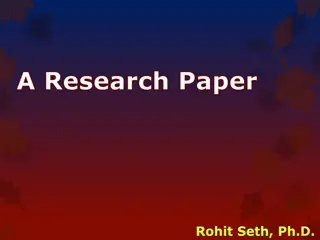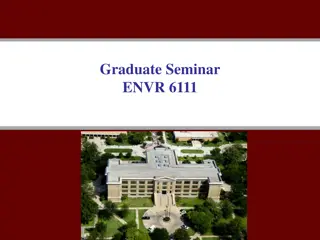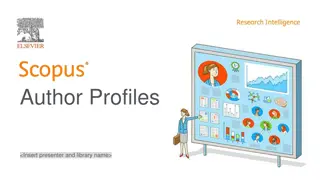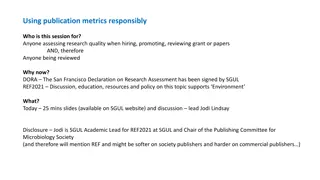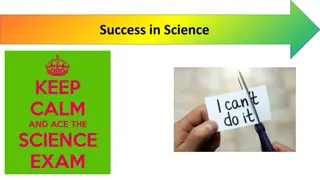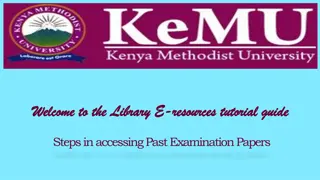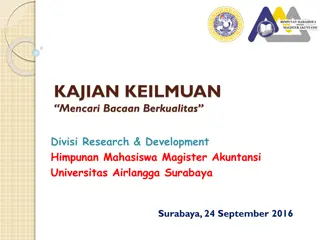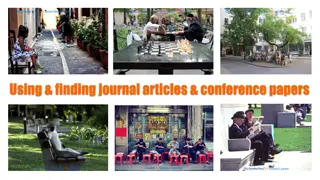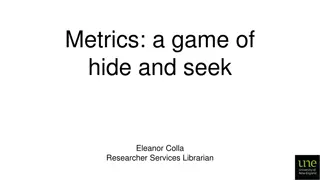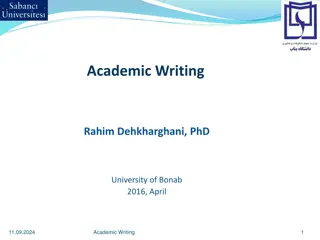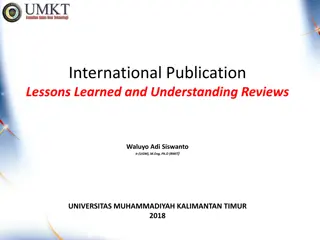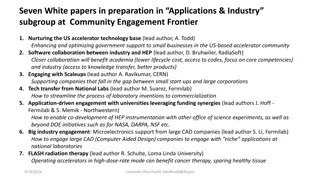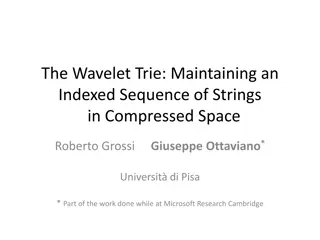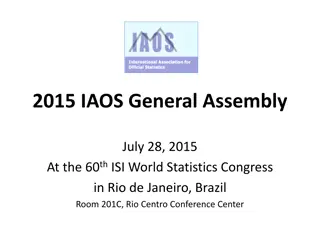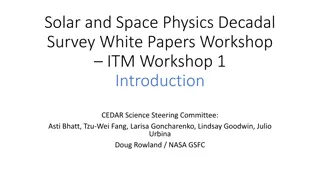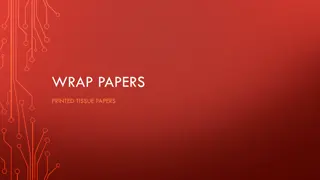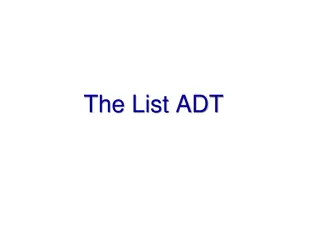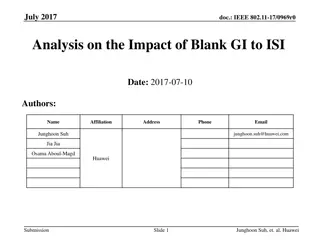Effective Strategies for Writing High-Quality Papers Indexed in ISI/Scopus
Learn about guidelines to enhance the quality of your research papers for acceptance in prestigious indexing platforms like ISI and Scopus. Explore reliable resources, categorization of journals, impact of citations, and selection criteria for publication.
Download Presentation

Please find below an Image/Link to download the presentation.
The content on the website is provided AS IS for your information and personal use only. It may not be sold, licensed, or shared on other websites without obtaining consent from the author.If you encounter any issues during the download, it is possible that the publisher has removed the file from their server.
You are allowed to download the files provided on this website for personal or commercial use, subject to the condition that they are used lawfully. All files are the property of their respective owners.
The content on the website is provided AS IS for your information and personal use only. It may not be sold, licensed, or shared on other websites without obtaining consent from the author.
E N D
Presentation Transcript
A Guideline Strategies to Write the High Quality Papers (ISI/Scopus) Index Prepared by Hussein Mohammed Ridha
Content Reliable Resources Cycling. Journal / Conference Index. Impact of Citation. H-Index. Researcher ID. Papers on Different Categorized Rejection Pointes for the Paper. How to get a good chance for acceptance our papers? High Impact Research The Main strategies to choose ISI journal from journal citation reports (JCR)
Types of selection resources Journals are classified into three phases: 1. Referee journals 2. Non-reliable index journals 3. Reliable index journals What does mean about index? Index refers to all journals that are in included in the database such as Scopus and International Scientific Indexing (ISI). Theses are considered as reliable index. https://mjl.clarivate.com/home Web of science (WoS) includes: Scopus and ISI. Only reliable index.
Reliable Resources Cycling ISI web of knowledge (not free access) Science Direct (not free access) IEEE Xplore (not free access) Springer (not free access) Wiley (not free access) MDPI (free access) Taylor & Francis (not free access) Some papers within high citation for the scientist people in you field. These paper must be published with (volume , Issues or page number ) under the journal or conferences
Journal / Conference Index Publication Journals Reliable Index (ISI Web of Knowledge , ISI Web of Science , Scopus Non Reliable Index Ex: Google Scholar, Worldcat, DOAJ, university library, scientific commons, Scrus, Scribed, EBSCO host and et.. Non -Index Conferences International Conference Reliable Index (ISI Proceeding, Scopus) Non Reliable Index Ex: Google Scholar, Worldcat, DOAJ, university library, scientific commons, Scrus, Scribed, EBSCO host and et.. Non -Index National Conferences (all these conferences are Non-Index) Cornell Cornell
Impact of Citation Citation Categorization in : ISI Web of Science Scopus Google Scholar Journal Citation Repots (JCR). Master Journal List Impact Factors
Web of Science Science Citation Index-Expanded Social Sciences Citation Index Arts & Humanities Citation Index Emerging Sources Citation Index (temperory) Any journal index in above databases are considered WoS and ISI. Emerging journals will be moved to one of the first three once the criteria that are required are achieved. The most effected to these journals are the highly cited scholars which they have at least 30 H_index in WoS and the number of citiations at least 70 non-self citations papers. Therefore, the systematic-review and review papers are most important for the authors to be highly-citated authors.
H-Index H-Index is an index that attempts to measure both the productivity and impact of the published work of a scientist or scholar. What is meaning of H-index: In journal aspect ? In researcher aspect What is the benefit from H-index ? How many types of H-index, it can account for each researcher ? How to calculate the H-Index ? How can increase the H-Index based on the gap of Non-publication?
Researcher ID Researcher ID: is an identifying system for scientific authors. Researcher ID based on ISI (web of knowledge) Manual created Manual edited and updated the article after indexing. Automatically account the citation after the manual updated. Researcher ID based on scopes Automatically created Automatically updated the article after indexing Can not be edit manual Automatically account the citation after the automated updated.
Papers on Different Categorized The Type of papers: Conference Paper. Review , Overview, Survey, Systematic Review, Hans on study papers. Research Paper (Full Length). Discussion Paper. Communication or Letter Paper and Patent. Winner/ Poster Paper.
Conference paper Abstract Introduction The purpose of the study The problem statement Literature review as critical selection. Proposed Method Discussion (How to solve the problem in future) Conclusion
Discussion Paper Abstract Introduction Literature review Your proposed Architecture Problem Validation Discussion on ability to resolve the problem statement theoretically with shown the trial results from the methods who try to resolve that problem. Discussion technically how to resolve the Sub-problems Potential direction the future works Conclusion
Communication or Letter Paper and Patent Structure for the communication or letter paper Abstract Introduction (More intention about the problem statement) Novelty Methods Results Conclusion Patent Patent International / National Don t published from the work who like to patent at lest one year from submission the form. The main point which focusing on your idea the generalities.
Rejection pointes for the paper Big mistakes on writing Language. Missing in main structure. Missing on contributions. The paper which are very Long terms. Missing in problem validation. Plagiarism. Missing on novelty Missing on evaluation.
How to get a good chance for acceptance our papers? Indicate on the acknowledgment about the grant/fund number. Study some papers from the journal targeting; regarding to the scope of the study. Your reference must be from reliable papers which are in the same field and highlight your problem statement directly. Add the limitations of the study as separate section before the conclusion. Choose strong title who reflect your paper are content a good knowledge. In the first lines for abstract refer to the significantly of study as two lines.
High impact research Traditional-disciplinary Multi-disciplinary. Inter-disciplinary. Trans-disciplinary. Cross-disciplinary.
Multi-disciplinary Draws on knowledge from different disciplines but stays within the boundaries of those fields knowledge is associated with more than one existing academic discipline or profession. A multidisciplinary community or project is made up of people from different disciplines and professions who are engaged in working together as equal stakeholders in addressing a common challenge. The key question is how well can the challenge be decomposed into nearly separable subparts, and then addressed via the distributed knowledge in the community or project team.
Inter-disciplinary Analyzes, Summation and Matches links between disciplines into a coordinated and logical whole. knowledge is the knowledge extensions that exist between or beyond existing academic disciplines or professions. The new knowledge may be claimed by members of none, one, both, or an emerging new academic discipline or profession. An interdisciplinary community or project is made up of people from multiple disciplines and professions who are engaged in creating and applying new knowledge as they work together as equal stakeholders in addressing a common challenge.
Trans-disciplinary Integrates the natural, social and health sciences in a humanitiescontext, and in doing so transcends each of their traditional boundaries. In practice, trans-disciplinary can be thought of as the union of all interdisciplinary efforts. While interdisciplinary teams may be creating new knowledge that lies between several existing disciplines. A trans-disciplinary team is more holistic and seeks to relate all disciplines into a coherent whole.
Cross-disciplinary Cross-disciplinary knowledge is that which explains aspects of one discipline in terms of another. Common examples of cross-disciplinary approaches are studies of the physics of music or the politics of literature
The Main Strategies to Choose ISI Journal The main strategies to choose ISI journal from journal citation reports (JCR) Multiply Category. Multidisciplinary Category. Tire Line Strategy.
Ranking of the journals The journals are ranked into four levels: Q1, Q2, Q3, Q4. The ranking depends on the impact factor (IF) :Number. Of citations/ Number. of publications for the last two years.
How can I know the journal are ISI. Use Journal Citation Report (JCR). Not free , includes only WoS. Master Journal List (MJL). Free access , includes WoS and WoK journals.
THANKS! Any questions? You can find me at hussain_mhammad@yahoo.com


